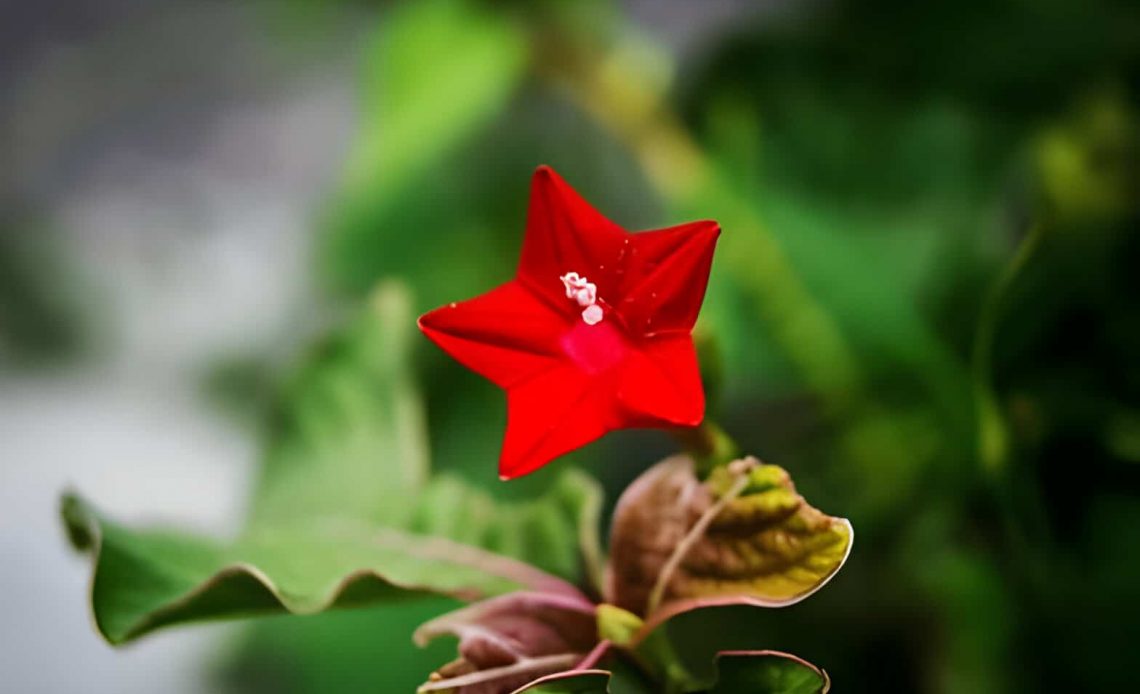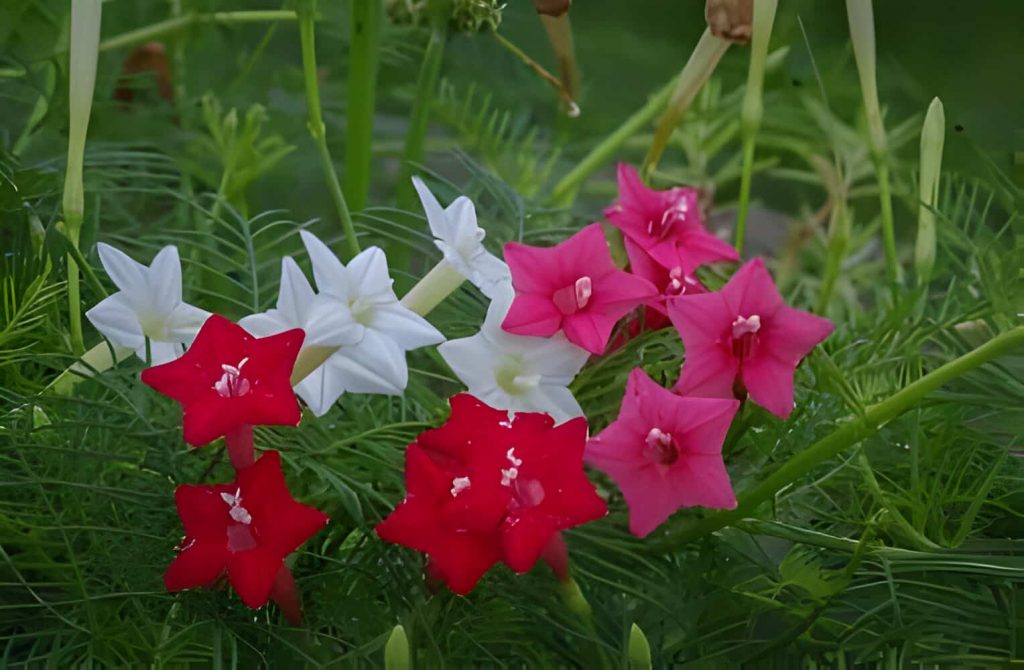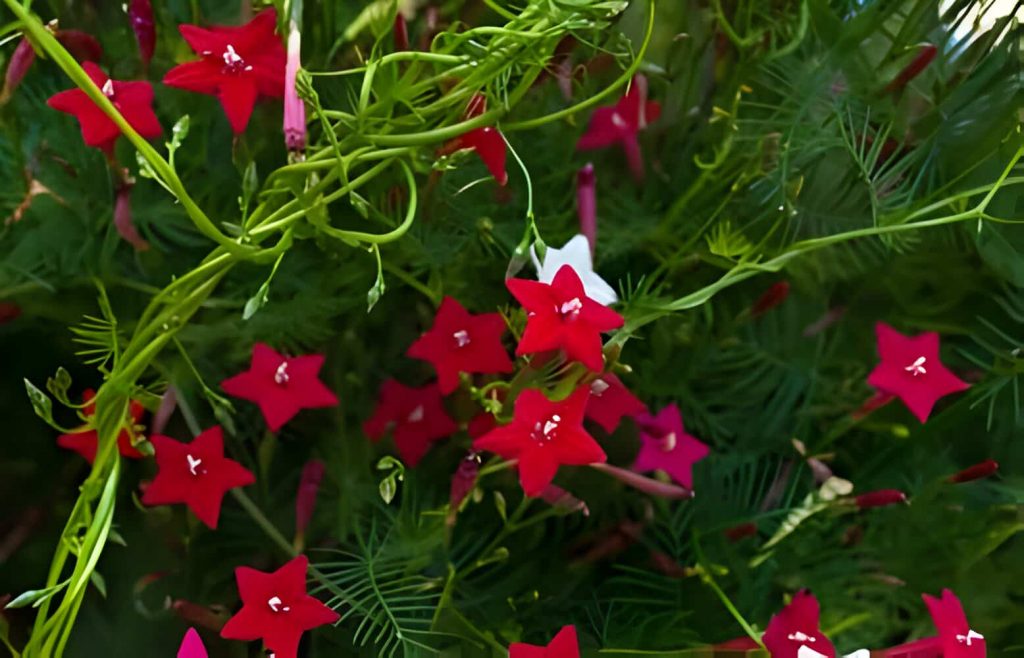
Cypress vine (Ipomoea quamoclit), with its delicate foliage and trumpet-shaped flowers, is a stunning addition to any garden. But its beauty isn’t the only perk. This fast-growing vine is also surprisingly low-maintenance. If you’re looking for a way to add vertical interest and color to your outdoor space, look no further than the cypress vine. Keep in mind that cypress vine, while beautiful, contains toxins that can be harmful if ingested by humans, cats, dogs, and horses. [1] Be sure to plant this vine in an area out of reach of pets and children.
| Common Name | Cypress Vine |
| Botanical Name | Ipomoea spp. (most commonly Ipomoea quamoclit) |
| Family | Convolvulaceae (Morning Glory Family) |
| Plant Type | Annual Vine |
| Mature Size | 6-10 feet tall |
| Sun Exposure | Full Sun |
| Soil Type | Well-drained |
| Soil pH | Slightly acidic to slightly alkaline (5.5-7.5) |
| Bloom Time | Early summer to first frost |
| Flower Color | Red, white, pink, purple |
| Hardiness Zones | 2-11 (as an annual) |
| Native Area | Tropical America |
| Toxicity | Moderate (toxic to humans, cats, dogs, and horses if ingested) |
Cypress Vine Care

With its vibrant red flowers and delicate foliage, cypress vine is a captivating annual climber. A relative of the morning glory, this quick-growing plant adds a splash of color to any garden. However, despite its vibrant beauty, the cypress vine has developed a somber symbolism in some cultures, Cypress vine flowers meaning death and mourning. This association might stem from its rapid growth and ephemeral nature, mirroring the transience of life.
Light
Cypress vine thrives in full sun, meaning at least six to eight hours of direct sunlight daily. This encourages abundant blooms and lush growth.
Soil
While cypress vine isn’t picky about soil quality, well-drained soil is crucial. Amend heavy clay soil with sand or compost to ensure proper drainage. The plant tolerates a wide range of pH levels, from slightly acidic to slightly alkaline.
Water
Water your cypress vine regularly, especially during hot and dry periods. Aim to keep the soil consistently moist but not soggy. As the plant matures, it becomes more drought tolerant.
Temperature and Humidity
Cypress vine flourishes in warm weather and tolerates average humidity levels.
Fertilizer
Fertilizing isn’t essential for cypress vine, but a light feeding with a balanced fertilizer before flowering can promote even more blooms.
Types of Cypress Vine

Sweet potato vine (Ipomoea batatas): This popular variety boasts heart-shaped leaves and vibrant blooms in shades of red, purple, and white.
Moonflower (Ipomoea alba): As the name suggests, the moonflower opens its fragrant white blooms at night, creating a magical evening display.
Cardinal climber (Ipomoea multifida): This vigorous vine features bright red, star-shaped flowers that attract hummingbirds and butterflies.
Pruning
Regular pruning is key to a thriving cypress vine. Pinch back healthy stems throughout the growing season to encourage bushier growth and more blooms. Make clean cuts with bypass pruners just above a leaf node. Prune strategically to control size, remove spent flowers for continuous blooming, and improve air circulation to prevent disease. Whether for bushier growth or rejuvenation, pruning throughout the year keeps your plant looking its best.
Propagating Cypress Vine
Cypress vine offers two easy propagation methods: seeds and stem cuttings. Sow seeds directly outdoors in warm soil after frost danger has passed, or start them indoors a few weeks beforehand. Seeds germinate quickly and only need light covering. For stem cuttings, choose healthy stems, remove lower leaves, and plant them in moist potting mix. Both methods require consistent moisture until roots develop, rewarding you with new plants to fill your garden with vibrant blooms.
How to Grow Cypress Vine From Seed
To grow cypress vine from seed, sow them directly outdoors in warm soil after frost danger has passed, or start them indoors 3-4 weeks before the last frost. Use a well-draining seed mix, barely cover seeds with soil, and keep them moist in a warm, bright location. Seedlings should emerge in 10-14 days. Once they have a few true leaves, harden them off and transplant them to a sunny spot with well-drained soil, spacing them 2-3 inches apart.
Potting and Repotting Cypress Vine
Cypress vine thrives in containers! Choose a pot at least 12 inches wide with drainage holes. Use a well-draining potting mix and water thoroughly. Repotting is rare, but watch for circling roots or fast-drying soil. Place your potted vine in full sun, water regularly, and provide support for climbing. This easy care, along with occasional fertilizer, will keep your container it flourishing.
Overwintering
This beautiful plant is a tender annual and will not survive freezing temperatures. In colder climates, you can either start new plants each year from seeds or cuttings, or overwinter the tubers of the sweet potato vine variety indoors.
How to Get Cypress Vines to Bloom

Providing ample sunlight, well-drained soil, and occasional light fertilization will all contribute to abundant blooms.
How Long Does Cypress Vine Bloom?
The plant is a prolific bloomer, typically flowering from early summer until the first frost.
What Do Cypress Vine’s Flowers Look and Smell Like?
Cypress vine flowers come in a variety of colors, including red, white, pink, and purple. They are trumpet-shaped and have a very faint, sweet fragrance.
How to Encourage More Blooms
Regularly deadheading spent flowers will help to promote continuous blooming throughout the season.
Caring for Cypress Vine After It Blooms
Deadheading not only encourages more blooms but also helps to prevent the plant from setting seed.
Common Problems
While generally a trouble-free plant, it can be susceptible to common garden pests like aphids and whiteflies. Insecticidal soap or neem oil spray can be used to control these issues.
With a little care, your plant will reward you with a season of vibrant blooms and lush foliage. So, why not add this easy-to-grow vine to your garden and enjoy its beauty all summer long?
FAQ
How long can a cypress vine live?
While cypress vine is technically classified as an annual, meaning it completes its lifecycle (germination, growth, flowering, seed production, death) within one growing season, it has a clever trick up its sleeve. It readily self-seeds, so if you allow the flowers to set seed and the seeds fall to the ground in a warm location, you’ll likely see new cypress vines sprout the following year without any additional planting on your part.
What are alternatives to cypress vines?
If you’re looking for a climbing vine with similar characteristics to cypress vine but with a longer lifespan, here are a few alternatives:
- Climbing Clematis (Clematis spp.): This perennial vine produces beautiful blooms in various colors throughout the summer and requires minimal maintenance. Also cleamatis symbolizes friendship.
- Morning Glory (Ipomoea purpurea): A close relative of cypress vine, morning glory is another fast-growing annual vine with vibrant blooms that come in a wider color range. However, it can be more aggressive than plant. Also morning glory symbolizes new beginings.
- Honeysuckle (Lonicera spp.): This perennial vine offers fragrant blooms and attracts hummingbirds. However, honeysuckle can be invasive in some regions, so check with your local authorities before planting.
Can cypress vines grow indoors?
Yes, it can be grown indoors in containers! However, it thrives on sunlight, so it’s crucial to provide a location with at least 6-8 hours of bright light daily. You’ll also need to ensure the pot has drainage holes and use a well-draining potting mix. Regularly rotate the pot to encourage even growth and provide a support structure for the vine to climb on. Keep in mind that indoor it may not bloom as profusely as those grown outdoors.

I’ve been wanting to try growing cypress vine. This guide is super helpful. I’m excited to give it a shot this summer!